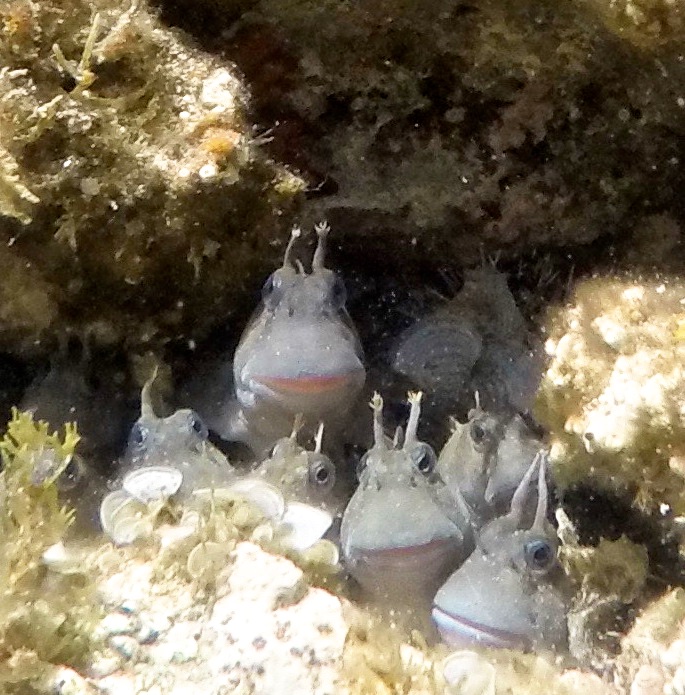Published in the Ocean Watch column, Honolulu Star-Advertiser © Susan Scott
August 24, 2015
A friend of a friend of a friend placed a GoPro in a tide pool on Oahu’s North Shore. When he downloaded the footage, he saw eight adorable faces peering at the camera.
“OMG they are so funny,” emailed the middle friend, who wrote “sea monkeys” in the subject line. “Any idea what they are?”
Much as I love the name sea monkeys, the little charmers in the photo are called blennies.
Most blennies are timid reef fish that range from 4 to 7 inches long, depending on species. Some hide in holes, others live in tide pools and several rest in the open on rocks or corals. These bottom blennies eat algae and dead plant and animal tissue.
 Endemic Hawaiian zebra blennies. Credit Willy Asprey.
Endemic Hawaiian zebra blennies. Credit Willy Asprey.
It’s easy to mistake blennies for gobies, and vice versa, because both have googly eyes, are similar in size and shyness, and hang out near rocky reefs. But here’s a clue: Startled blennies usually dash into holes tail-first; gobies dive in head first. Another sign is that many blennies have either frilly or antennaelike tendrils above their eyes. So if a fish with eyelashes or “My Favorite Martian” antennae is peeking from its hole, it’s a blenny. Gobies lack such tendrils.
Because bottom blennies have no swim bladders to control their buoyancy, the fish sink when they stop swimming. Some blennies make up for this bottom heaviness by performing acrobatics. When startled, they leap from pool to pool. One called the Hawaiian zebra blenny can detect a potential predator up to 50 feet from its tide pool. If the danger approaches, the fish will leap, skip or slide to the next pool, somehow knowing where that is.
Zebra blennies have been seen jumping as high as 2 feet above the water’s surface. Sometimes, the fish behave like frogs, slipping nearly out of the water to bask in the sun.
In addition to bottom blennies, the family has a branch of free swimmers called fang or sabertooth blennies. These fish use a set of curved lower teeth for defense. When caught by a predator, the blenny bites the inside of the captor’s mouth, causing it to spit out its potential meal intact. Unlike their vegetarian cousins, fang blennies are hit-and-run carnivores, nipping the sides of fish to eat mucus and scales.
The Ewa fang blenny mimics the cleaner wrasse, causing unsuspecting victims to swim toward the blenny thinking it’s going to lose some parasites. Instead, it loses some skin. Fang blennies sometimes bite divers, but the tiny nip does no damage.
I bought a GoPro recently and wasn’t quite sure what todowithit. I do now. I’m going hunting for sea monkeys.